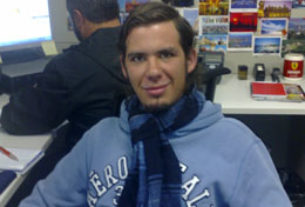This month’s cover features an etching by local artist and graphoanalyst, Rita Pomade, who admits to having a life-long fascination with lines and their potential for expression. Rita works in pen and ink, printmaking, linocuts, and pastel, as well as interpreting the lines of her client’s handwriting, for which she studied two and a half years in order to certify as a master graphoanalyst. For a sample of her handwriting analysis abilities, turn to p.49 for this month’s installment of Write-On!
Rita has led a varied, non-conventional life, which began in New York City, The Big Apple. She was raised in upstate New York, in a town called Beacon. Always drawn to art, her early love was ceramics; she produced her first piece at the age of 8. Later, she majored in fine arts at Hunter College, a branch of the New York City University, with a concentration in ceramics.
Upon graduating, one of her initial jobs was working for the Department of Education for the City of NY, where she helped talented underprivileged youths, mostly blacks and Latinos, to integrate into the education system and make the most of their innate artistic abilities. One of the reasons for her first trip to Mexico was an attempt to connect with the culture of some of her students, and so be able to put them in touch with their creative roots, instead of the curriculum, which focused primarily on European contributions to art.
Rita came to Mexico for a summer vacation and ended up staying for seven years! She wrote her letter of resignation, hooked up with an acquaintance from NY, Hugo Velasquez, who had a large art studio in Mexico City. Rita worked with him in the studio for two years, wrote as an art critic and interviewer for Mexico This Month, and taught English in order to afford remaining in the country. Following this stage, Rita emigrated to Montreal, Canada, and was part of a group of educators who started the first Fine Arts Elementary School, where all learning was approached or integrated into the study of an artistic discipline. She remained with the school as Art Coordinator for three, rewarding years. The school continues to this day.
From there, Rita’s life took a far-flung turn, and she moved to Taiwan, ostensibly to build a boat and sail around the world. While building the boat, which took a year, she studied calligraphy and Chinese brush painting, reinforcing her appreciation for the powerful expressions that can be achieved with simple lines.
Her artistic focus soon shifted from the three dimensional world of ceramics, to the linear plane, which was much easier to transport and practice on the six and a half years spent sailing and living on their boat. They sailed the China Sea, to Borneo, Malaysia, Thailand, India and the Red Sea, finally selling the boat in Majorca, Spain, and living a time in Europe before returning to Montreal. It was in Majorca that Rita first attended a lecture on handwriting analysis, given by a nun in Spanish.
When she returned to Montreal, it was time to redefine herself again, and reading an article by a psychologist who was using graphoanalysis techniques in the treatment of her patients, Rita decided that she would see if she couldn’t make a living at something she felt deeply attracted to. It took several years of study to become a certified graphoanalyst, but she ran the full course, earning a scholarship along the way and drawing constantly. Rita helped subsidize her schooling years by producing T-shirts, mugs, notepads, and the like, with images she silk-screened from her drawings.
This article appears courtesy of the Chapala Review, a monthly Newspaper published in Ajijic, Jalisco, Mexico. The focus is the Lake Chapala area. The goal is to provide quality information about the area, its stories, events, history, culture and people.


